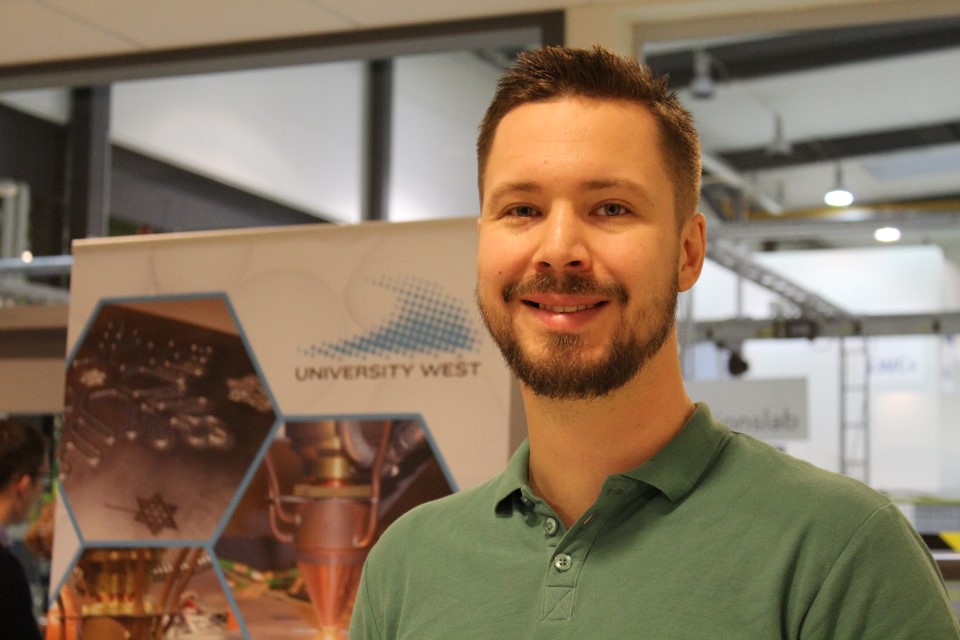Additive manufacturing can improve the aerospace industry
08 Jan 2018
Research by Andreas Segerstark presents new possibilities for more effective use of Laser Metal Powder Deposition (LMPD) in the aerospace industry. Manufacturing becomes more flexible and waste of expensive aerospace materials can be reduced by up to 90 percent. – I’ve found important correlations between the main process parameters and their effects on the material during the manufacturing process, says Andreas Segerstark, who defended his doctoral thesis a few days before Christmas.

To aerospace industries like GKN Aerospace the new knowledge can contribute to a more effective additive manufacturing process using powder based laser metal deposition. Higher flexibility, shorter lead time and considerably reduced waste material are some effects that Andreas Segerstark mentions when he talks about his research.
To put it simply, in LMPD-technology a robot welds several thin beads of metal powder close to each other and in multiple layers, until the component has gained its final geometry.
– The LMPD-technology is a complement to conventional manufacturing methods used today. For example components are built in complex geometries by adding metal layers on simpler cast or forgings, explains Andreas Segerstark.
– The technology is also used for repairing damaged components that are sensitive to excessive heating. Metal deposition has an advantage when it is used to repair or strengthen areas where heat input needs to be controlled.
Four important process parameters
The focus of Andreas’ research project was to understand how the process parameters cooperate and how they influence the material properties during the manufacturing process.
- The most influential process parameters are the laser power, scanning speed, powder feeding rate and powder standoff distance. And they have a significant effect on the phase formation, phase transformation, grain structure and cracking susceptibility of the material.
Increased flexibility and reduced waste material
Andreas study is based on the expensive superalloy Alloy-718, an important and commonly used material in commercial jet engines.
- Optimal use of the LMPD -technology in manufacturing can reduce waste material by up to 90 percent in certain components.
- Enhanced manufacturing flexibility is another great opportunity that comes with LMPD -technology. The industry saves time and money when production easily and quickly can adapt to new components; thanks to digital control there is no need for new tools.
New temperature measurement method
Reliable temperature measurement during the deposition process has been a major challenge during the research work. To manage that, Andreas developed and evaluated a new temperature measurement method, in addition to his ordinary research work.
- We used thin stainless steel sheets to shield the thermocouple where temperature was measured.
The steel sheets protected the thermocouples from direct exposure of the laser light and thus prevented the laser from interfering with the temperature measurements.
Close collaboration with GKN Aerospace
The idea behind the research project is a result of a long term partnership between GKN Aerospace in Trollhättan and University West. They identified a need to investigate more about LMPD-technology.
- Research in the field of the additive manufacturing was not common four years ago when the PhD student position was advertised, particularly not in the field of LMPD. This area of research was a subject I wanted to learn more about and I was tempted by the connections to welding technology.
Continuing work with the research results
GKN Aerospace has shown great interest in Andreas’ research and their collaboration continues even after Andreas’ PhD exam. His employment at the R&D-department begins in January 2018.
- A lot of work remains to be done in terms of implementing the research results in their manufacturing. There is a great interest in additive manufacturing today and the need for further development is clear. I really look forward to continue working in this field.
Andreas Segerstarks research project has been financed by University West, GKN Aerospace Sweden AB, Region Västra Götaland, Swedish National Space Board, Swedish Agency for Economic and Regional Growth and Sweden’s Innovation Agency.
To the doctoral thesis "Laser Metal Deposition using Alloy 718 Powder – Influence of Process Parameters on Material Characteristics"


